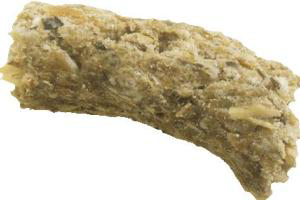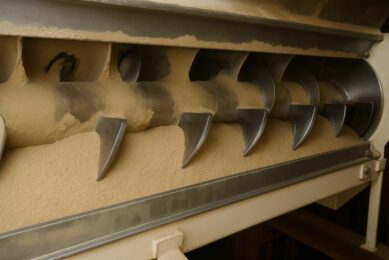From mash to hightech feed pellets

The technical results in pig production are constantly increasing. The improved quality of the feed is a big part of this success. According to the Dutch feed company Agrifirm, results can be further improved by using the extrusion technique. With the current high feed prices, the interest for this type of feed is increasing.
By Emmy Koeleman
Once feed ingredients have been ground and mixed, they can either be fed as mash or subjected to further processing that usually involves heat or heat and pressure in combination. The most common forms of this ‘thermal processing’ encountered in the feed industry are pelleting, roasting, steam flaking, and to a lesser extent extrusion and expansion. The cheapest way of feeding pigs is offering them the mash, leaving out the relatively expensive processing techniques. With feeding mash it is important that it is finely grounded so that the animal can digest it properly. When the meal is too rough, the feed intake and hence feed conversion ratio can be negatively influenced, especially in current times where animal feed is very expensive, due to the scarcity of raw materials in the world market. Feeding meal to animals has more negative aspects, because the feed is not extruded with a certain high temperature, certain pathogens are not killed. These can create intestinal health problems in the pigs.
In addition, the digestibility of the energy in the feed is said to be around four percent lower than pressed feed. The feed intake with meal can also be lower which in particular is not wanted by farmers that raise boars as they often have a lower feed intake than female pigs.
Patented extrusion process
Over the years, feed companies started to use more processing techniques to make animal feed. The most advanced way of producing pig feed is extrusion by using an extruder machine. This technique is commonly used in the pet food and human food industry, but not so common in the production of pig feeds. Basically, an extruder is a long barrel with a screw auger inside which is specially designed to subject feed mixtures to high heat and steam pressure. When feed exits the die at the end of the barrel, trapped steam blows off rapidly, the soft warm pellets expand, and a low density floating pellet is produced. Extruders are very versatile, and can make feeds with many different characteristics. Since a few years, the Dutch animal feed producer Agrifirm uses (and patented) this technique to make pig feed under the brand name Air Line. Several trials already proved that by using the extruded pig feed the digestibility of the feed is improved.
Agrifirm notices that with the current high feed prices farmers are evn more focused on digestibility and feed conversion ratio. The interest for the Air Line feed is therefore increasing.
Better fermentation
But what is so special about this feed then and can it be used for all age groups in pigs? Sector manager pigs at Agrifirm, Bert Fierkens, explains that the extruder in combination with a vacuum coater produces a type of pig feed that is much more ‘airy’ inside than conventional feed. The airy (or popcorn like) structure inside the pellet makes it digestible for the animals. Trials have shown that the digestibility can be improved up to 6%, in comparison to conventional feed. This means that the animals have 6% more energy available for growth. This is particularly interesting for producing boars. “The structure makes the pellet better fall apart in the stomach of the pig. This way the amount of intestinal problems caused by bad digestion of feed is reduced,” says Fierkens. By filling the porous structures of the pellets with fat, the feed gets more concentrated. The feed is around 2-3% more expensive than conventional feed; after correction for the 6% better digestibility the feed in fact is cheaper. The Air
Line pellets are often only used in the growth phase of the boars and fattening pigs. For lactating sows, this type of feed is also used. In the southern part of the Netherlands, around 80% of the sows are fed on the special ‘lacto version’ of the Air Line feed. Trials have shown that the milk production of the sows is better. The sows also produce a better quality manure. Studies on the Dutch research Centre ‘VIC Sterksel’ showed that the lacto version of Air Line is 12% better available for the sows than conventional feed. The average litter weight was 6 kg higher and the piglets were in a better shape, compared to conventional feed. According to Bert Fierkens from Agrifirm, data from AgroVision showed that it is even possible to produce one extra piglets per litter. The Air Line range is also available for piglets. The farrowing version of Air Line now even represents the most sold farrowing feed within the Agrifirm portfolio.
Increased capacity in the Netherlands
Air Line feed has been on the Dutch market for a couple of years, but Agrifirm is constantly improving the process and has been increasing the production capacity lately. Air Line feed is produced on the location Veghel. Demand, however, became higher than the available capacity. Therefore a new expander to make this type of feed has been installed in October 2012 at the Agrifirm location in Zwolle, in the Eastern part of the Netherlands. The capacity of the machine is 15 tonnes per hour. This is around 100,000 tonnes annually. The location Zwolle produces 300,000 tonne pig feed in total. By increasing the production of Air Line feed, the company also aims to lower the costs. Currently the Air Line feed is primarily sold in the Netherlands, but Agrifirm also intends to sell the product to neighbouring countries. As a whole the company produces 3.2 million tonnes of feed in the Netherlands.











